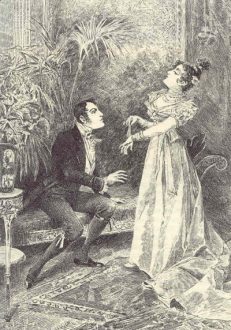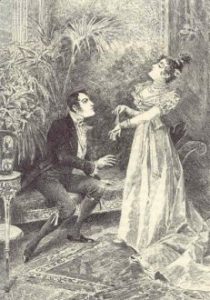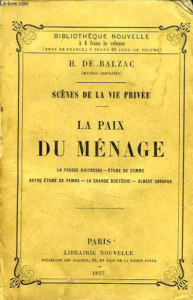
Domestic Bliss
THE HUMAN COMEDY – Honoré de Balzac First volume of works of Honoré de Balzac edited by widow André Houssiaux, publisher, Hebert and Co, successors, 7 rue Perronet – Paris (1877)
Scenes from private life 
LA PAIX DU MENAGE – Physiology of marriage
DEDIE A MA CHERE NIECE VALENTINE SURVILLE This novel was published in 1830 by Mame and Delaunay-Vallée, in Scènes de la vie privée, then in 1842 by Furne, in La Comédie Humaine, still in Scènes de la vie privée.
Analysis of the work La Paix du ménage is a short story written in July 1829, probably intended as one of the anecdotes in Balzac’s recently published Physiologie du mariage. It’s the demarcation of a comte de Dufresny in Les Amusements sérieux et comiques d’un Siamois à Paris. It is, says Balzac, “advice given to women to be indulgent of their husbands’ mistakes”. This significance gave it a place in Scenes from Private Life. But it doesn’t match it in execution or style. Balzac was well aware of this, and in theIntroduction to the book, he has it done in just a few lines. by Félix Davin: “This scene is the weakest of all, and suffers from the smallness of the frame originally adopted. If the author left it, perhaps he thought it necessary to please all minds, those who love easel paintings, as well as those who are passionate about large canvases.”
History The story describes the blind passion of the Comte de Soulanges for Madame la Comtesse de Vaudremont, then the most beautiful woman in Paris, the fashionable queen. The story features the Comte de Soulanges and Baron Martial de la Roche-Hugon vying for this coquette’s graces. As this little drama unfolds, Count Léon de Soulanges is in disgrace in the eyes of Mme de Vaudremont, who prefers the Napoleon-protected Baron Martial de la Roche-Hugon, who is promised a sumptuous embassy and is making eyes at her. The Count of Soulanges, distraught at the game of seduction between his belle and Martial, fails to notice the presence of his wife Hortense, who has come to spy on him at the ball given by the Count of Gondreville. Madly in love with her husband, Hortense, a neglected wife, suffers in silence from her husband’s distress. Nothing turns out the way people want it to, and the evening’s events will hurt many vanities and change the course of things:  a)Madame de Vaudremont, who has her eye on Martial, will be disappointed to see herself preferred by the beautiful stranger of the evening (Mme de Soulanges); b)Martial, surrendering himself to the charm of the unknown woman, loses both Mme de Vaudremont and Mme de Soulanges, who plays him for a fool and whose success he fails to achieve; c) Colonel Montcornet wins the good graces of Madame de Vaudremont, with whom he lived in close harmony for some time – she was to perish in the fire that forever made famous the ball given by the Emperor of Austria, on the occasion of the marriage of Emperor Napoleon to the daughter of Emperor Francis II. Anecdote from the story Out of love for Mme de Vaudremont, Léon de Soulanges substitutes a diamond ring belonging to his wife Hortense as a gift for his mistress. Mme de Vaudremont then made a gift of it to Martial…who, in order to win over his stranger (Hortense de Soulanges), presents it to her. Hortense recovers her jewel and her husband. Indeed, flattered by his wife’s success and beauty, he returns to her entirely. Paris, July 1829
a)Madame de Vaudremont, who has her eye on Martial, will be disappointed to see herself preferred by the beautiful stranger of the evening (Mme de Soulanges); b)Martial, surrendering himself to the charm of the unknown woman, loses both Mme de Vaudremont and Mme de Soulanges, who plays him for a fool and whose success he fails to achieve; c) Colonel Montcornet wins the good graces of Madame de Vaudremont, with whom he lived in close harmony for some time – she was to perish in the fire that forever made famous the ball given by the Emperor of Austria, on the occasion of the marriage of Emperor Napoleon to the daughter of Emperor Francis II. Anecdote from the story Out of love for Mme de Vaudremont, Léon de Soulanges substitutes a diamond ring belonging to his wife Hortense as a gift for his mistress. Mme de Vaudremont then made a gift of it to Martial…who, in order to win over his stranger (Hortense de Soulanges), presents it to her. Hortense recovers her jewel and her husband. Indeed, flattered by his wife’s success and beauty, he returns to her entirely. Paris, July 1829
Sources: 1) Analysis and story based on the preface to the complete works of the Comédie Humaine (tome III) published by France Loisirs 1985 under the auspices of the Société des Amis d’Honoré de Balzac – 2)
Source for additional notes: Wikipedia.
Genealogy of characters Vaudremont: (comtesse de) widow who died in 1810 in the fire at the Austrian embassy. Soulanges : (de) Noble family from Burgundy, represented by Count Léon de Soulanges, born in 1777, military officer and peer of France. Married in 1807, Hortense, a relative of the Duchesse de Lansac, from whom: a military son; from whom a military son and a daughter Amélie, successively refused to Montcornet and Philippe Bridau(unless they were two different daughters); Two more ancestors, a marshal and a marquis of Soulanges-hautemer Montcornet: (comte de), general then marshal of France (1774-1838). Married Virginie de Troisville, born in 1797. Widowed, she married Emile Blondet. From an affair with Mlle Fortin, Montcornet had a natural daughter, Valérie, who went on to marry Marneffe and Crevel.
Character genealogy source: Félicien Marceau “Balzac et son monde” Gallimard.
No Comments